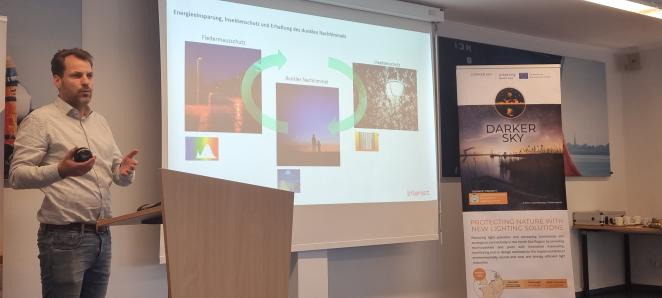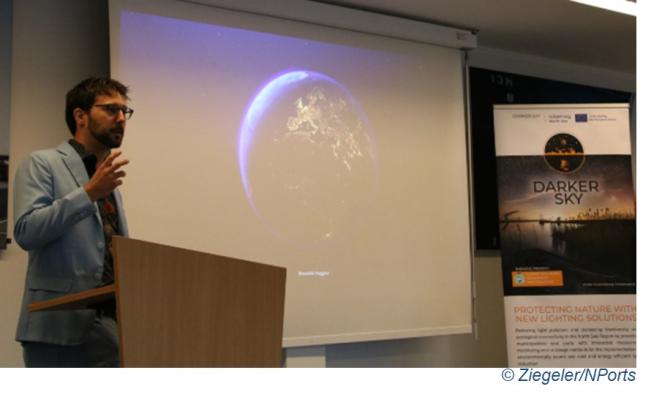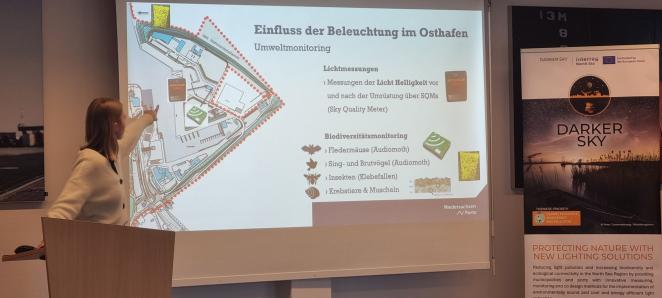The NPorts event held on April 18, 2024, primarily focused on the technical and legal aspects of harbour lighting and light modifications at the Norddeich harbour and how to combine them with environmental protection goals. Electricians and electrical engineers from different NPorts locations participated in an internal morning roundtable discussion. The afternoon session was open to the Lower Saxony DARKER SKY project team, interested ports and stakeholders, aiming to address technical and legal questions concerning harbour lighting
© Ziegeler/NPorts
The impact of light pollution
Introduction by Prof. Dr. Björn Poppe (Carl von Ossietzky University of Oldenburg
Light pollution negatively impacts various species: insects are drawn to light, making them easy prey or leading to exhaustion and death; nocturnal predators like owls are detected by their prey; birds are attracted to lights and often collide with buildings, causing billions of deaths annually. Humans are also affected, experiencing sleep disturbances and disruptions in melatonin production.
The severity of this issue is particularly high near protected areas such as the Wadden Sea (World Heritage status), prompting research on light pollution's impact on biodiversity by measuring and verifying various environmental parameters. While ports are not protected areas, they do influence nearby protected zones. For this reason, lighting in ports needs to be adapted with new light reduction solutions.
The balancing act of implementing new lighting concepts
Switching to LED’s could be part of new lighting solutions. However, the transition poses challenges. Indeed, LEDs are cost-effective, producing significant light output for little cost. But many LED lights have a high blue light content, affecting the day-night rhythms of biodiversity. Also, safety and regulatory issues arise since workplace lighting is planned according to norms and regulations, often leading to continuous illumination even when no work is being conducted.
Finding the right balance for lighting is challenging. Well-planned lighting for a specific application should:
- Provide safe and pleasant illumination,
- Consume the least amount of energy,
- Disrupt the ecosystem as little as possible,
- and avoid light pollution.
These aspects often conflict with each other and need to be individually balanced.
The issue of light pollution is widely recognized and awareness of the topic is steadily increasing. In lighting upgrades, the focus has shifted from energy savings to broader environmental protection. Also, manufacturers are gradually adapting to the issue of light pollution and working on appropriate solutions. Understanding the perspectives of different stakeholders could be improved and there is potential for mutually agreeable solutions.

© Ziegeler/NPorts
A call for smart lighting
Philips Outdoor Multisensor - Connected to Interact City Application
In the light of innovative light reduction concepts, the inclusion of smart, motion-sensor-based lighting could contribute to promising solutions. Jan Schubauer (Signify) presented the Philips Outdoor Multisensor, connected to the Interact City Application, is an advanced lighting control system that uses multiple sensors and smart technology to optimise outdoor lighting for safety, energy efficiency and reduced environmental impact.
The Outdoor Multisensor includes multiple sensors supporting various light control applications, such as radar sensors that brighten lights only upon detecting movement or sensor failure. The smart feature of "following lighting" temporarily overrides the actual dimming schedule, brightening lights to 100% upon detecting movement and then returning to the pre-set schedule. It also features a local Mesh Network for grouping lights and an integrated photocell to ensure lights only operate at night.
Benefits of this setup:
- ensures lighting is provided when needed
- without compromising safety
- minimises energy consumption
Conflict potential in ports

© Ziegeler/NPorts
Implementing new lighting solutions in ports comes with potential conflicts between minimising the environmental impact and complying with the regulatory regimes of ports. Benedikt Huggins (Faculty of Law, University of Heidelberg) provided an overview of these regimes impacting ports.
Regulatory frameworks in Germany
Ports are regulated under various laws, including water protection laws (WHG), nature conservation laws and emission control laws. Ports must ensure their lighting systems do not cause harmful environmental changes, comply with safety regulations, and balance multiple regulatory requirements.
- Water protection:
Ports must operate without causing detrimental changes to water properties, impacting public water supply.
- Nature conservation:
Regulations include bans and avoidance obligations in protected areas, with the necessity for FFH-compatibility assessments.
- Emission control:
Ports must minimise and avoid emissions from non-permitted facilities, adhering to regulations to protect adjacent areas.
- Workplace safety and traffic security:
Regulations mandate minimum illumination levels for outdoor workplaces, complicating the balance between safety and environmental impact.
Challenges in ports
Ports face unique challenges. Ships often dock without prior notice, leading to unpredictability. Cargo handling occurs around the clock and at irregular times, with unclear definitions and frequencies of handling activities, especially from a legal perspective. Most port facilities are publicly accessible, with some areas subject to ISPS regulations. Frequently changing companies and personnel in the ports affect coordination and continuity of operations. These activities are subject to different legal requirements, making compliance complex.
The legal frameworks often remain somewhat unclear for local actors. There is willingness to act, but:
- The unclear state of regulations, directives, and technical recommendations and norms can lead to over-lighting to ensure legal compliance.
- The regulations are complex and offer little flexibility, limiting potential actions,
- Lighting control affects organisational and operational processes in the port.
Light modification concept of the Norddeich Eastern harbour

© Ziegeler/NPorts
As part of the DARKER SKY project, the NPorts harbour in Norddeich takes up this challenge and aims to reduce the light emissions and environmental impact.
Denise Schablitzki (NPorts) presented the light modification concept for the Eastern harbour of Norddeich which is one of DARKER SKY’s demonstrator sites. The existing lighting infrastructure will be optimised ecologically while aiming to fulfil legal lighting requirements and minimise environmental impact. These modifications will take place in summer 2024. The adapted lighting concept is based on, among others, the company guideline for environmentally friendly and uniform lighting of the NPorts harbours.
Light modification measures
- LED technology:
Replacing current lamps with energy-efficient LEDs to reduce CO2 emissions and support climate and environmental protection.
- Light colour:
Switching from 3000K to 2700K to reduce blue light impact on nature.
- Light direction:
Proper light angles prevent long light scattering into the atmosphere and water, minimising ecological impact.
- Shielding:
Shielded lights prevent upward light emission, reducing overall light pollution.
- Lighting control:
Smart, demand-based lighting control further reduces light pollution.
- Light intensity:
Defined minimum lighting levels for different harbour areas, with flexibility to adjust as standards change.
- Motion sensors:
Utilising radar or camera sensors to dim lighting based on actual need, further reducing emissions.
- Experiencing light colours:
A test area for various light colours (1800K-2700K) will be installed to enhance stakeholder acceptance and understanding.
Summary - Take home messages
Significant problem for biodiversity: Light pollution notably affects biodiversity, especially near protected areas, necessitating further research on its ecosystem impact.
No optimal lighting solution: Balancing safe, energy-efficient, and minimally intrusive lighting is challenging, requiring careful consideration of conflicting priorities.
Willingness to reduce light pollution: Awareness and readiness among various actors to address light pollution is growing, with environmental protection now being one of the key considerations in lighting upgrades.
Unclear legal framework: Ambiguities in regulations can lead to excessive lighting to ensure compliance, restricting flexibility and increasing complexity for actors.
Special conditions in ports: Ports' unpredictable and diverse activities, along with their legal and operational complexities, require tailored lighting solutions to balance safety, efficiency, and environmental considerations.
The event highlighted the complexities and collaborative efforts needed to address light pollution in ports, emphasising the importance of interdisciplinary, innovative approaches and regulatory clarity. DARKER SKY aims to implement those approaches and to support ports and municipalities in planning and implementing light reduction solutions.
